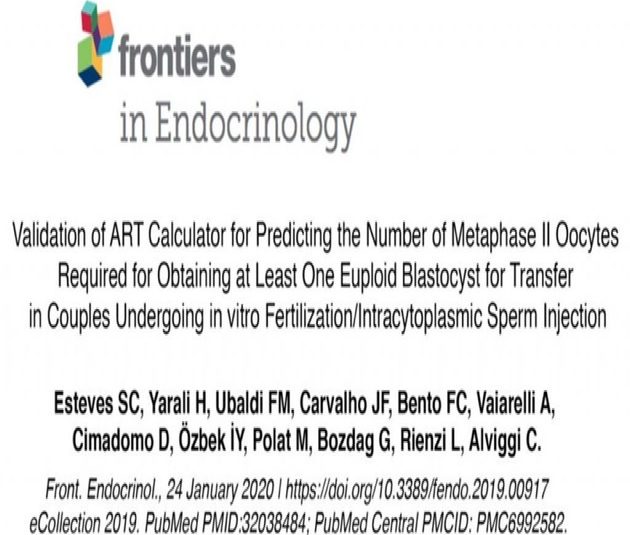
Validation of ART Calculator for Predicting the Number of Metaphase II Oocytes Required for Obtaining at Least One Euploid Blastocyst for Transfer in Couples Undergoing in vitro Fertilization/Intracytoplasmic Sperm Injection
Esteves SC, Yarali H, Ubaldi FM, Carvalho JF, Bento FC, Vaiarelli A, Cimadomo D, Özbek İY, Polat M, Bozdag G, Rienzi L, Alviggi C.
Front. Endocrinol., 24 January 2020 | https://doi.org/10.3389/fendo.2019.00917 eCollection 2019. PubMed PMID:32038484; PubMed Central PMCID: PMC6992582.
ABSTRACT
This multicenter study evaluated the reliability of the recently published ART calculator for predicting the minimum number of metaphase II (MII) oocytes (MIImin) to obtain at least one euploid blastocyst in patients undergoing in vitro fertilization/intracytoplasmic sperm injection (IVF/ICSI). We used clinical and embryonic retrospective data of 1,464 consecutive infertile couples who underwent IVF/ICSI with the intention to have preimplantation genetic testing for aneuploidy. The validation procedure followed a stepwise approach. Firstly, we assessed the distribution of euploid blastocysts per patient and found that it followed a negative binomial distribution. Secondly, we used generalized linear models and applied the Lasso procedure-including MII oocytes to adjust the data-to select the factors predicting the response variable “euploid blastocyst.” Third, a logistic regression model-fit to the binomial response euploid (yes/no) for each MII oocyte-was built using the relevant factors. The observational unit was the “woman” whereas the response was the pair (m, n), where n is the number of retrieved MII oocytes and m the corresponding number of euploid blastocysts. The model was internally validated by randomly splitting the data into training and validation sets. The R-squares (~0.25) and the area under the ROC curve (~0.70) did not differ between the training and validation datasets. Fourth, mathematical equations and the calculated probabilities generated by the validation model were used to determine the MIImin required for obtaining at least one euploid blastocyst according to different success probabilities. Lastly, we compared the fittings generated by the validation model and the ART calculator and assessed the predictive value of the latter using the validation dataset. The fittings were sufficiently close for both the estimated probabilities of blastocyst euploid per MII oocyte (r = 0.91) and MIImin (r = 0.88). The ART calculator positive predictive values, i.e., the frequency of patients with at least one euploid blastocyst among those who achieved the estimated MIImin, were 84.8%, 87.5%, and 90.0% for 70%, 80%, and 90% predicted probabilities of success, respectively. The ART calculator effectively predicts the MIImin needed to achieve at least one euploid blastocyst in individual patients undergoing IVF/ICSI. The prediction tool might be used for counseling and planning IVF/ICSI treatments.
KEYWORDS: ART calculator; POSEIDON criteria; assisted reproductive technology; decision support models; intracytoplasmic sperm injection; preimplantation genetic testing for aneuploidy; validation study
